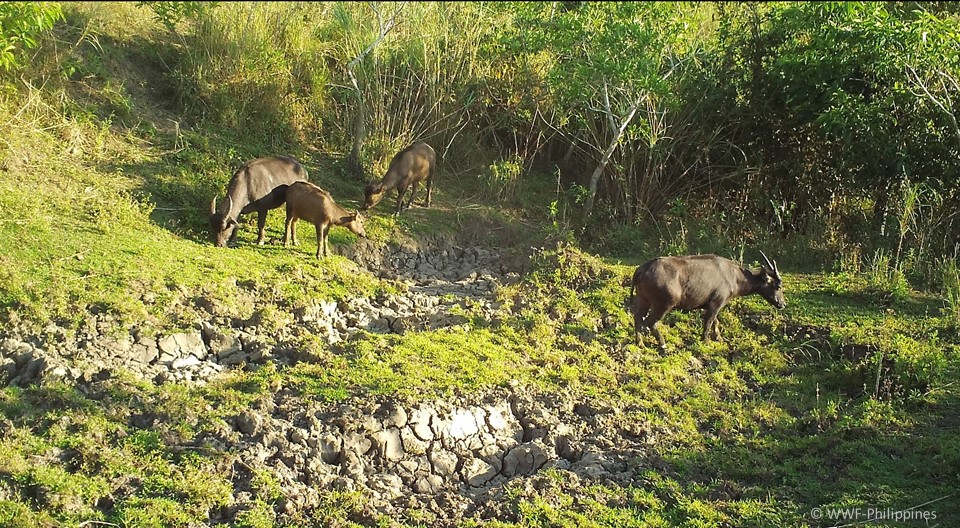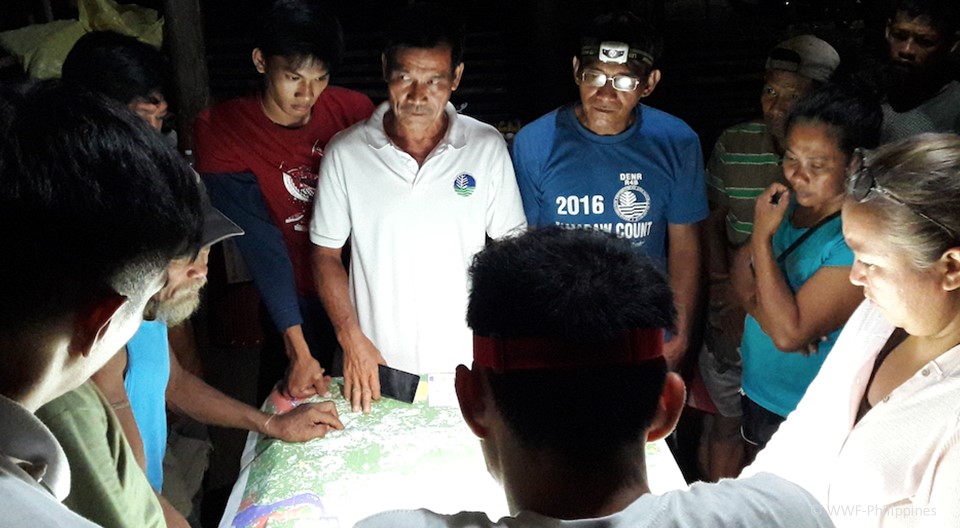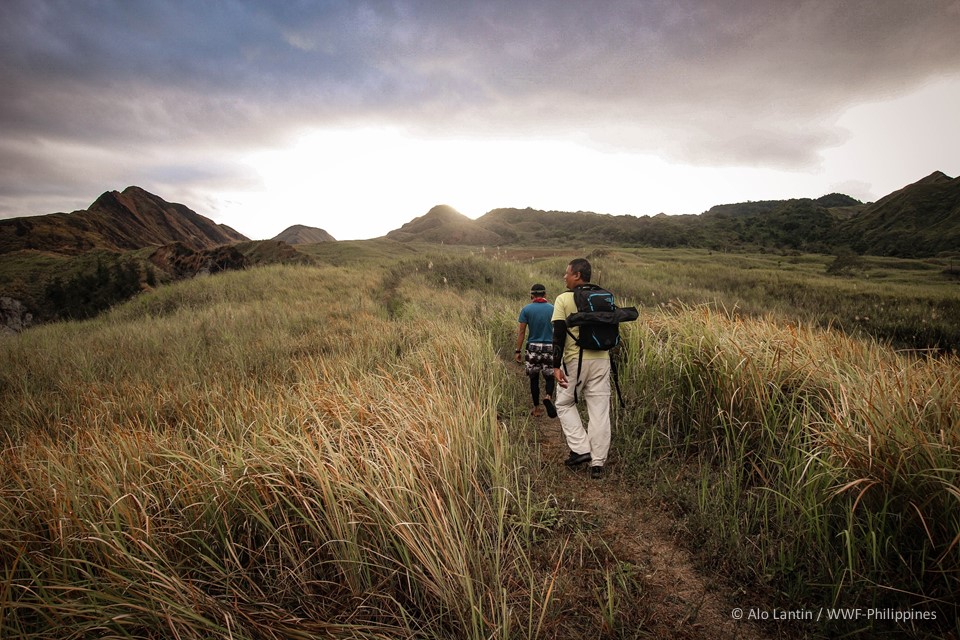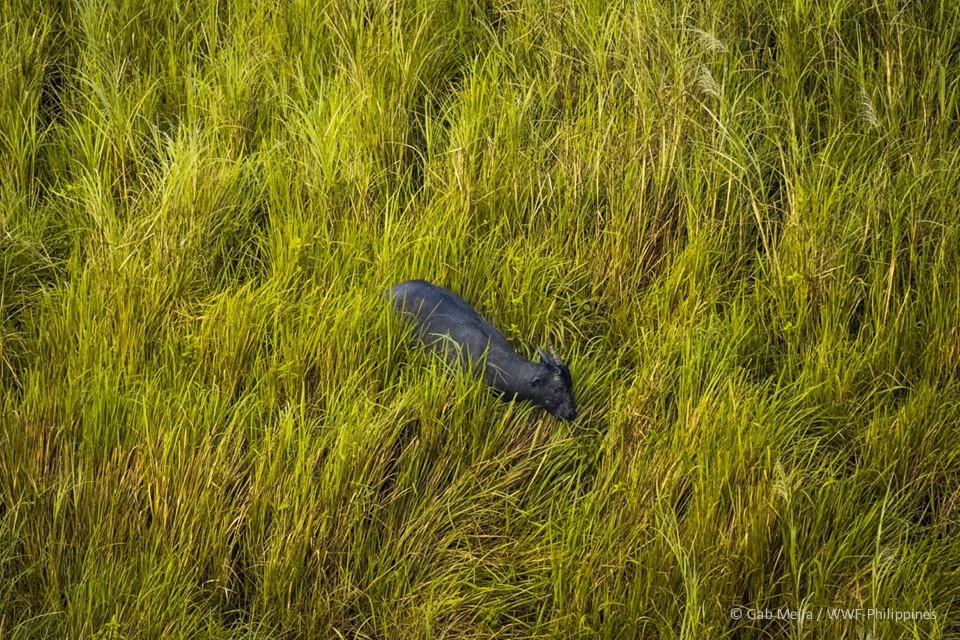Annual Tamaraw Population Count Identifies New Individuals across Mindoro
June 2019

A group of tamaraws are captured by a camera trap, set up at the “Tamaraw Plaza,” a tamaraw hotspot within Mts. Iglit-Baco Natural Park. Photograph © WWF-Philippines
*Population numbers will be updated upon release of official statement of the DENR.
The annual tamaraw (Bubalus mindorensis) population count headed by the Department of Environment and Natural Resources (DENR) reported around 600 individuals with new populations confirmed outside of Mts. Iglit-Baco Natural Park, the area known to have the most number of the world’s rarest buffalo.
The current overall tamaraw population suggests an increase from the 523 that were identified in 2018. 480 tamaraw individuals were confirmed in Mts. Iglit-Baco, while new populations were confirmed by the DENR-Tamaraw Conservation Project (TCP) using new survey methodologies. A population of tamaraws was identified in the Upper Amanay Ranges on the border of Occidental and Oriental Mindoro, while another is believed to inhabit the Aruyan-Malate Critical Habitat in Sablayan, Occidental Mindoro. This suggests an increase in the tamaraw population throughout all of Mindoro. Calves and newborns were identified amongst the population, proving that the species has indeed continued to breed and grow in number.

Tau Buid Tribe Leader Fausto Novelozo describes the location of the tamaraw in Mts. Iglit-Baco Natural Park as well as the range of the indigenous people’s ancestral domain to members of the Tamaraw habitat mapping team in 2018, led by WWF-Philippines. Photograph © WWF-Philippines
The tamaraw is listed as critically endangered by the International Union for the Conservation of Nature (IUCN), with only 154 individuals documented in the year 2000. WWF-Philippines launched the Western Mindoro Integrated Conservation Program in 2012 together with partners the DENR-TCP and the Far Eastern University (FEU), when the tamaraw population was at 327. The project is securing both coastal and land resources in Western Mindoro, and looks to help tamaraw numbers increase to 600 by the year 2020.
Beyond Mts. Iglit-Baco, the DENR-TCP works with organizations such as the Mindoro Biodiversity Conservation Foundation, Inc. (MBCFI) to conserve local ecosystems and species, including the tamaraw.

WWF-Philippines Western Mindoro Project Manager Luis Caraan follows a park ranger up to the “Tamaraw Plaza.” WWF-Philippines works with the DENR-TCP and its partner organizations to monitor the tamaraw population in Mts. Iglit-Baco Natural Park. Photograph © Alo Lantin / WWF-Philippines
“There've been anecdotal reports of sightings in certain areas, but those couldn't be validated. Only in 2019 was there validation. There'd been sightings of manure and markings before, but this is the first time anyone's actually seen and counted these populations,” said WWF-Philippines Western Mindoro Project Manager Luis Caraan, citing the field validation reports of the TCP. Prior to 2019, confirmed tamaraw sightings had been limited to Mts. Iglit-Baco Natural Park. In 2018, all 523 tamaraws were counted in the Natural Park during the 2018 Tamaraw Population Census held by the DENR-TCP, WWF-Philippines and partner organizations.
“This is good news, and it shows that the tamaraws exist all over Mindoro. The presence of calves is also proof that the population is increasing. What we need to think about is, why were they confined to these areas?” continued Caraan, explaining how human activity has drastically reduced the tamaraw population from its historic numbers. This has driven the endemic buffalo to sparse corners of Mindoro island, with small and unconfirmed pockets of individuals outside Mts. Iglit-Baco Natural Park.
According to Caraan, the protocols being used in the population count are fit for other big animals present in other countries as opposed to the tamaraw, which is endemic to the Philippines. This means that the data provided cannot give an exact number on how many tamaraws are currently living in Mindoro – but there has definitely been an increase, says Caraan.

A tamaraw grazes on long grass on the slopes of Mts. Iglit-Baco. Photograph © Gab Mejia / WWF-Philippines
“It’s the practices that threaten the tamaraw, the ones that are encroaching on their territory. They’re running out of land, they’re being pushed back,” concluded Caraan. Through comprehensive multi-party conservation work the tamaraw species has been allowed to recover. Human activity continues to threaten the species, however, and continued support is needed to keep the species from extinction.
Further funding, research, and institutional support is both urgent and vital in providing information necessary for the conservation of the remaining tamaraws. As efforts continue, however, and as calves are born and as more and more tamaraws are spotted beyond the boundaries of Mts. Iglit-Baco, hope persists that this species is returning from the brink of extinction.
For more information, please contact:
Communications & Media Manager Mr. Dan Ramirez (dramirez@wwf.org.ph)
Project Manager of Western Mindoro Mr. Luis Caraan (lcaraan@wwf.org.ph)
